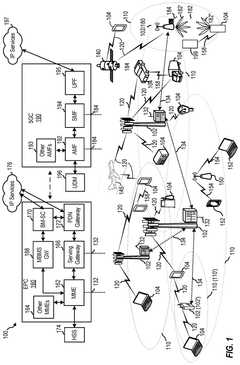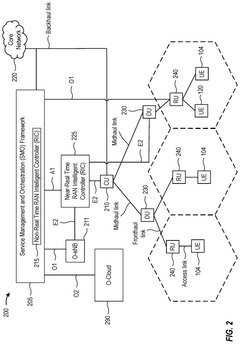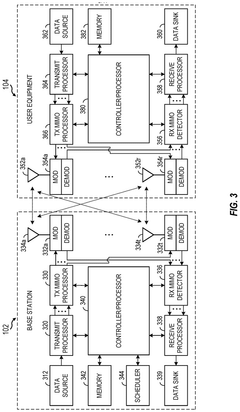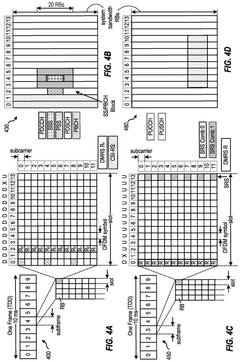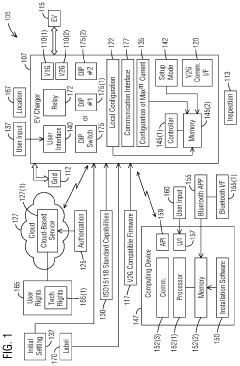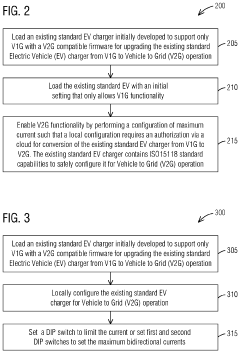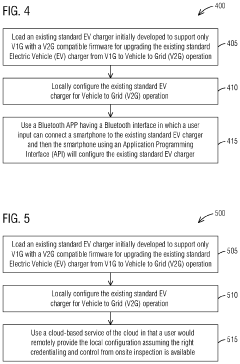Exploring the Multifaceted Impact of V2G
AUG 8, 20259 MIN READ
Generate Your Research Report Instantly with AI Agent
Patsnap Eureka helps you evaluate technical feasibility & market potential.
V2G Technology Evolution and Objectives
Vehicle-to-Grid (V2G) technology has emerged as a transformative concept in the energy and transportation sectors, evolving rapidly over the past two decades. The fundamental idea behind V2G is to enable bidirectional power flow between electric vehicles (EVs) and the power grid, allowing EVs to serve as mobile energy storage units.
The evolution of V2G technology can be traced back to the early 2000s when researchers first proposed the concept. Initially, the focus was on developing the basic infrastructure and communication protocols necessary for bidirectional power flow. As EV adoption increased and battery technology improved, V2G research expanded to explore more sophisticated applications and integration strategies.
A significant milestone in V2G development was the implementation of pilot projects in various countries, demonstrating the feasibility of the technology in real-world scenarios. These projects helped identify technical challenges and potential benefits, driving further innovation and refinement of V2G systems.
The objectives of V2G technology have evolved alongside its technical capabilities. Initially, the primary goal was to provide grid stability and load balancing services. However, as the technology matured, objectives expanded to include renewable energy integration, demand response management, and even revenue generation for EV owners.
Currently, V2G technology aims to address several key challenges in the energy sector. These include mitigating the intermittency of renewable energy sources, reducing peak demand on the grid, and providing ancillary services such as frequency regulation and voltage support. Additionally, V2G seeks to create new value streams for EV owners, potentially offsetting the higher upfront costs of electric vehicles.
Looking forward, the objectives of V2G technology are becoming increasingly ambitious. Researchers and industry leaders are exploring the potential for V2G to play a crucial role in smart city infrastructure, enabling more efficient and sustainable urban energy systems. There is also growing interest in leveraging V2G as part of a broader vehicle-to-everything (V2X) ecosystem, where EVs can interact with homes, buildings, and other infrastructure to optimize energy use and enhance resilience.
As V2G technology continues to evolve, its objectives are likely to expand further, potentially encompassing areas such as emergency power supply during natural disasters, support for off-grid and microgrid systems, and integration with emerging technologies like autonomous vehicles and artificial intelligence for predictive energy management.
The evolution of V2G technology can be traced back to the early 2000s when researchers first proposed the concept. Initially, the focus was on developing the basic infrastructure and communication protocols necessary for bidirectional power flow. As EV adoption increased and battery technology improved, V2G research expanded to explore more sophisticated applications and integration strategies.
A significant milestone in V2G development was the implementation of pilot projects in various countries, demonstrating the feasibility of the technology in real-world scenarios. These projects helped identify technical challenges and potential benefits, driving further innovation and refinement of V2G systems.
The objectives of V2G technology have evolved alongside its technical capabilities. Initially, the primary goal was to provide grid stability and load balancing services. However, as the technology matured, objectives expanded to include renewable energy integration, demand response management, and even revenue generation for EV owners.
Currently, V2G technology aims to address several key challenges in the energy sector. These include mitigating the intermittency of renewable energy sources, reducing peak demand on the grid, and providing ancillary services such as frequency regulation and voltage support. Additionally, V2G seeks to create new value streams for EV owners, potentially offsetting the higher upfront costs of electric vehicles.
Looking forward, the objectives of V2G technology are becoming increasingly ambitious. Researchers and industry leaders are exploring the potential for V2G to play a crucial role in smart city infrastructure, enabling more efficient and sustainable urban energy systems. There is also growing interest in leveraging V2G as part of a broader vehicle-to-everything (V2X) ecosystem, where EVs can interact with homes, buildings, and other infrastructure to optimize energy use and enhance resilience.
As V2G technology continues to evolve, its objectives are likely to expand further, potentially encompassing areas such as emergency power supply during natural disasters, support for off-grid and microgrid systems, and integration with emerging technologies like autonomous vehicles and artificial intelligence for predictive energy management.
Market Demand Analysis for V2G Solutions
The market demand for Vehicle-to-Grid (V2G) solutions is experiencing significant growth, driven by the increasing adoption of electric vehicles (EVs) and the need for grid stability. As the global EV market expands, with sales reaching 10.5 million units in 2022, the potential for V2G technology to provide valuable grid services becomes more apparent. This technology allows EVs to not only consume electricity but also feed it back into the grid, creating a symbiotic relationship between transportation and energy sectors.
The primary market drivers for V2G solutions include the growing concerns over grid reliability and the integration of renewable energy sources. As power grids face challenges from intermittent renewable generation, V2G offers a promising solution for load balancing and frequency regulation. Utility companies are increasingly recognizing the value of EVs as mobile energy storage units, capable of providing ancillary services during peak demand periods.
In the residential sector, homeowners with EVs are showing interest in V2G systems as a means to reduce electricity costs and potentially generate revenue by selling excess energy back to the grid. This trend is particularly strong in regions with time-of-use electricity pricing, where the price differential between peak and off-peak hours creates economic incentives for V2G participation.
The commercial and industrial sectors also present significant market opportunities for V2G solutions. Fleet operators are exploring V2G as a way to optimize charging costs and generate additional revenue streams. Large-scale V2G implementations in commercial settings can provide substantial grid support services, attracting the attention of both energy providers and businesses looking to monetize their EV assets.
Government policies and regulations play a crucial role in shaping the V2G market. Many countries are introducing incentives and regulatory frameworks to encourage V2G adoption, recognizing its potential to enhance grid resilience and support the transition to renewable energy. These policies are expected to accelerate market growth and drive innovation in V2G technologies.
The market for V2G solutions is also influenced by advancements in battery technology and smart charging infrastructure. As battery costs continue to decline and energy density improves, the economic viability of V2G systems increases. Furthermore, the development of bidirectional chargers and smart grid technologies is creating a more favorable ecosystem for V2G implementation.
Despite the promising outlook, challenges remain in the widespread adoption of V2G technology. Consumer awareness and acceptance, standardization of V2G protocols, and concerns over battery degradation are among the factors that need to be addressed to fully realize the market potential. However, as these barriers are overcome, the V2G market is poised for substantial growth, with projections indicating a compound annual growth rate of over 25% in the coming years.
The primary market drivers for V2G solutions include the growing concerns over grid reliability and the integration of renewable energy sources. As power grids face challenges from intermittent renewable generation, V2G offers a promising solution for load balancing and frequency regulation. Utility companies are increasingly recognizing the value of EVs as mobile energy storage units, capable of providing ancillary services during peak demand periods.
In the residential sector, homeowners with EVs are showing interest in V2G systems as a means to reduce electricity costs and potentially generate revenue by selling excess energy back to the grid. This trend is particularly strong in regions with time-of-use electricity pricing, where the price differential between peak and off-peak hours creates economic incentives for V2G participation.
The commercial and industrial sectors also present significant market opportunities for V2G solutions. Fleet operators are exploring V2G as a way to optimize charging costs and generate additional revenue streams. Large-scale V2G implementations in commercial settings can provide substantial grid support services, attracting the attention of both energy providers and businesses looking to monetize their EV assets.
Government policies and regulations play a crucial role in shaping the V2G market. Many countries are introducing incentives and regulatory frameworks to encourage V2G adoption, recognizing its potential to enhance grid resilience and support the transition to renewable energy. These policies are expected to accelerate market growth and drive innovation in V2G technologies.
The market for V2G solutions is also influenced by advancements in battery technology and smart charging infrastructure. As battery costs continue to decline and energy density improves, the economic viability of V2G systems increases. Furthermore, the development of bidirectional chargers and smart grid technologies is creating a more favorable ecosystem for V2G implementation.
Despite the promising outlook, challenges remain in the widespread adoption of V2G technology. Consumer awareness and acceptance, standardization of V2G protocols, and concerns over battery degradation are among the factors that need to be addressed to fully realize the market potential. However, as these barriers are overcome, the V2G market is poised for substantial growth, with projections indicating a compound annual growth rate of over 25% in the coming years.
V2G Implementation Challenges and Constraints
The implementation of Vehicle-to-Grid (V2G) technology faces several significant challenges and constraints that must be addressed for widespread adoption. One of the primary obstacles is the current lack of standardization in V2G protocols and infrastructure. This absence of unified standards creates interoperability issues between different electric vehicle (EV) models, charging stations, and power grid systems, hindering seamless integration and communication.
Another major challenge lies in the potential impact on battery life and performance. Frequent charging and discharging cycles associated with V2G operations may accelerate battery degradation, raising concerns about the long-term viability and cost-effectiveness of the technology. This issue necessitates further research and development in battery technology to enhance durability and mitigate the effects of increased cycling.
The existing power grid infrastructure presents additional constraints for V2G implementation. Many current grid systems are not designed to handle bidirectional power flows, requiring significant upgrades and modifications to accommodate V2G capabilities. This includes the need for advanced metering systems, smart grid technologies, and robust communication networks to manage the complex interactions between vehicles and the grid.
Regulatory and policy frameworks also pose challenges to V2G adoption. The lack of clear regulations and incentives in many regions creates uncertainty for stakeholders, including utilities, vehicle manufacturers, and consumers. Developing appropriate policies that address issues such as energy pricing, grid access, and compensation mechanisms for V2G services is crucial for creating a supportive environment for technology deployment.
Consumer acceptance and behavior represent another significant hurdle. Many EV owners may be hesitant to participate in V2G programs due to concerns about battery wear, reduced vehicle availability, and privacy issues related to data sharing. Overcoming these reservations requires extensive education, outreach, and the development of user-friendly interfaces that simplify participation and demonstrate tangible benefits.
Technical challenges related to grid stability and power quality must also be addressed. The intermittent nature of V2G power flows can potentially introduce voltage fluctuations and harmonics into the grid, necessitating advanced control systems and power electronics to maintain grid stability and power quality standards.
Lastly, the economic viability of V2G implementation remains a significant constraint. The high initial costs associated with V2G-capable vehicles, charging infrastructure, and grid upgrades may deter investment without clear pathways to profitability. Developing sustainable business models and demonstrating the long-term economic benefits of V2G to all stakeholders is essential for overcoming this challenge and driving widespread adoption.
Another major challenge lies in the potential impact on battery life and performance. Frequent charging and discharging cycles associated with V2G operations may accelerate battery degradation, raising concerns about the long-term viability and cost-effectiveness of the technology. This issue necessitates further research and development in battery technology to enhance durability and mitigate the effects of increased cycling.
The existing power grid infrastructure presents additional constraints for V2G implementation. Many current grid systems are not designed to handle bidirectional power flows, requiring significant upgrades and modifications to accommodate V2G capabilities. This includes the need for advanced metering systems, smart grid technologies, and robust communication networks to manage the complex interactions between vehicles and the grid.
Regulatory and policy frameworks also pose challenges to V2G adoption. The lack of clear regulations and incentives in many regions creates uncertainty for stakeholders, including utilities, vehicle manufacturers, and consumers. Developing appropriate policies that address issues such as energy pricing, grid access, and compensation mechanisms for V2G services is crucial for creating a supportive environment for technology deployment.
Consumer acceptance and behavior represent another significant hurdle. Many EV owners may be hesitant to participate in V2G programs due to concerns about battery wear, reduced vehicle availability, and privacy issues related to data sharing. Overcoming these reservations requires extensive education, outreach, and the development of user-friendly interfaces that simplify participation and demonstrate tangible benefits.
Technical challenges related to grid stability and power quality must also be addressed. The intermittent nature of V2G power flows can potentially introduce voltage fluctuations and harmonics into the grid, necessitating advanced control systems and power electronics to maintain grid stability and power quality standards.
Lastly, the economic viability of V2G implementation remains a significant constraint. The high initial costs associated with V2G-capable vehicles, charging infrastructure, and grid upgrades may deter investment without clear pathways to profitability. Developing sustainable business models and demonstrating the long-term economic benefits of V2G to all stakeholders is essential for overcoming this challenge and driving widespread adoption.
Current V2G Integration Approaches
01 V2G system architecture and integration
This category focuses on the overall architecture and integration of Vehicle-to-Grid (V2G) systems. It includes designs for connecting electric vehicles to the power grid, communication protocols between vehicles and grid infrastructure, and methods for managing bidirectional power flow. These systems enable electric vehicles to not only draw power from the grid but also feed power back when needed, contributing to grid stability and energy management.- V2G system architecture and communication: This category focuses on the overall system architecture and communication protocols for Vehicle-to-Grid (V2G) technology. It includes methods for establishing secure and efficient communication between electric vehicles and the power grid, as well as the design of control systems to manage bidirectional power flow. These systems enable electric vehicles to not only charge from the grid but also feed power back when needed, contributing to grid stability and energy management.
- Grid integration and load balancing: This aspect deals with integrating electric vehicles into the existing power grid infrastructure and using them for load balancing. It involves developing algorithms and strategies to optimize the use of vehicle batteries as distributed energy storage units. These technologies aim to smooth out peak demand, improve grid reliability, and increase the integration of renewable energy sources by utilizing the storage capacity of electric vehicle fleets.
- Battery management and optimization: This category encompasses technologies for managing and optimizing the use of electric vehicle batteries in V2G applications. It includes methods for preserving battery life while participating in grid services, intelligent charging and discharging strategies, and systems for predicting and managing battery degradation. These innovations aim to maximize the value of V2G services while minimizing the impact on vehicle battery longevity.
- Economic models and incentive structures: This point focuses on developing economic models and incentive structures to encourage V2G participation. It includes methods for calculating and distributing financial benefits to vehicle owners, pricing strategies for V2G services, and market mechanisms to integrate V2G into existing energy markets. These innovations aim to create win-win scenarios for vehicle owners, grid operators, and energy providers.
- V2G applications in renewable energy integration: This category explores the use of V2G technology to support the integration of renewable energy sources into the power grid. It includes methods for using electric vehicle fleets as flexible storage to balance intermittent renewable generation, strategies for coordinating V2G services with solar and wind power forecasts, and systems for optimizing the interplay between V2G and renewable energy sources to reduce reliance on fossil fuels and improve grid stability.
02 Charging and discharging control strategies
This point covers various control strategies for optimizing the charging and discharging of electric vehicles in V2G systems. It includes algorithms for determining when to charge or discharge based on grid conditions, energy prices, and vehicle usage patterns. These strategies aim to maximize the benefits of V2G technology for both vehicle owners and grid operators, while ensuring the longevity of vehicle batteries.Expand Specific Solutions03 Grid stabilization and load balancing
This category addresses the use of V2G technology for stabilizing the power grid and balancing loads. It includes methods for using electric vehicle batteries as distributed energy storage to smooth out fluctuations in renewable energy generation, provide frequency regulation, and support peak shaving. These applications help improve grid reliability and facilitate the integration of more renewable energy sources.Expand Specific Solutions04 Economic models and incentive structures
This point focuses on the economic aspects of V2G technology, including pricing models, incentive structures, and market mechanisms. It covers methods for compensating vehicle owners for providing grid services, optimizing energy trading between vehicles and the grid, and creating business models that make V2G economically viable for all stakeholders involved.Expand Specific Solutions05 V2G infrastructure and hardware
This category encompasses the physical infrastructure and hardware components necessary for implementing V2G systems. It includes designs for bidirectional chargers, smart meters, and communication devices that enable seamless interaction between vehicles and the grid. Additionally, it covers innovations in power electronics and energy management systems that facilitate efficient and reliable V2G operations.Expand Specific Solutions
Key Players in V2G Industry
The V2G (Vehicle-to-Grid) technology market is in its early growth stage, characterized by increasing adoption and rapid innovation. The global V2G market size is projected to expand significantly in the coming years, driven by the rising penetration of electric vehicles and the need for grid stability. While the technology is still evolving, several key players are making strides in its development and commercialization. Companies like LG Electronics, Samsung Electronics, and Qualcomm are leveraging their expertise in electronics and communications to advance V2G solutions. Automotive giants such as Apple and Huawei are also exploring V2G capabilities as part of their broader electric vehicle strategies. Additionally, power and energy companies like State Grid and Contemporary Amperex Technology are contributing to the V2G ecosystem, focusing on grid integration and battery technologies.
QUALCOMM, Inc.
Technical Solution: Qualcomm has developed a V2G solution that leverages its expertise in wireless communication and IoT technologies. Their system utilizes advanced cellular vehicle-to-everything (C-V2X) technology to enable seamless communication between vehicles and the grid infrastructure[7]. Qualcomm's V2G platform includes a dedicated chipset that supports high-speed, low-latency data transfer, essential for real-time energy management and grid balancing[9]. The company has also integrated their AI Engine into the V2G system, allowing for intelligent decision-making in energy trading and optimizing charging/discharging cycles based on user behavior and grid conditions[11].
Strengths: Strong capabilities in wireless communication and IoT integration, potentially offering superior connectivity solutions for V2G. Weaknesses: May lack direct experience in power grid management and energy trading systems.
Samsung Electronics Co., Ltd.
Technical Solution: Samsung has developed a comprehensive V2G ecosystem that leverages its expertise in consumer electronics, semiconductors, and smart home technologies. Their solution includes advanced power electronics for bidirectional charging, capable of handling up to 22kW AC and 350kW DC power transfer[13]. Samsung's V2G system integrates with their SmartThings platform, allowing users to manage their vehicle's energy flow alongside other smart home devices[15]. The company has also developed specialized batteries with enhanced cycle life and thermal management systems optimized for V2G applications[17]. Samsung's V2G platform incorporates blockchain technology for secure and transparent energy trading between vehicles and the grid.
Strengths: Broad technological expertise and potential for integration with smart home ecosystems. Weaknesses: Relatively new entrant in the automotive and energy sectors, may face challenges in establishing partnerships with established players.
Core V2G Innovations and Patents
Device to grid discharging and charging
PatentPendingUS20250162436A1
Innovation
- A method for device-to-grid charge transfer that involves a controller associated with the electric grid requesting charge transfer from a wireless communication device, with the device sending a message indicating acceptance or rejection based on power requirements, and configuring the charge transfer accordingly.
Upgrading an existing standard electric vehicle (EV) charger from grid to vehicle (V1G) to v1g plus vehicle to grid (V2G) operation
PatentPendingUS20240201974A1
Innovation
- A method to locally configure existing standard AC EV chargers with ISO15118 capabilities for V2G operation by loading V2G compatible firmware, authorizing via the cloud, and configuring maximum current, allowing bi-directional charging/discharging through a communication interface.
V2G Grid Impact Assessment
Vehicle-to-Grid (V2G) technology has the potential to significantly impact the electrical grid in various ways. The integration of V2G systems can enhance grid stability, improve load balancing, and provide ancillary services. One of the primary benefits is the ability to use electric vehicle (EV) batteries as distributed energy storage units, which can help smooth out demand peaks and fill in supply troughs.
During periods of high electricity demand, V2G-enabled vehicles can feed power back into the grid, reducing strain on traditional power plants and potentially decreasing the need for peaker plants. This bidirectional flow of energy can lead to more efficient utilization of existing grid infrastructure and may defer costly upgrades to transmission and distribution systems.
V2G technology also supports the integration of renewable energy sources by providing a flexible storage solution for intermittent generation from solar and wind. When renewable energy production is high but demand is low, excess electricity can be stored in EV batteries. Conversely, when renewable generation drops, these batteries can supply power back to the grid, helping to maintain a stable energy supply.
The implementation of V2G systems can contribute to frequency regulation and voltage support, two critical aspects of grid stability. By rapidly responding to grid signals, EVs can help maintain the balance between electricity supply and demand, potentially reducing the reliance on traditional spinning reserves and improving overall grid reliability.
However, the widespread adoption of V2G technology also presents challenges for grid operators. The increased complexity of managing a large number of distributed energy resources requires advanced control systems and communication infrastructure. Grid operators must develop sophisticated algorithms to optimize the charging and discharging of EVs while considering factors such as battery degradation, user preferences, and grid conditions.
Furthermore, the impact of V2G on local distribution networks needs careful assessment. High penetration of EVs in a particular area could lead to overloading of transformers and lines if not properly managed. This necessitates the development of smart charging strategies and potential reinforcement of local grid infrastructure.
In conclusion, V2G technology offers significant potential benefits for grid operation and stability, but its successful implementation requires careful planning, advanced control systems, and potentially substantial investments in grid infrastructure. As the technology matures and deployment increases, ongoing assessment and adaptation of grid management strategies will be crucial to fully realize the benefits of V2G while mitigating potential challenges.
During periods of high electricity demand, V2G-enabled vehicles can feed power back into the grid, reducing strain on traditional power plants and potentially decreasing the need for peaker plants. This bidirectional flow of energy can lead to more efficient utilization of existing grid infrastructure and may defer costly upgrades to transmission and distribution systems.
V2G technology also supports the integration of renewable energy sources by providing a flexible storage solution for intermittent generation from solar and wind. When renewable energy production is high but demand is low, excess electricity can be stored in EV batteries. Conversely, when renewable generation drops, these batteries can supply power back to the grid, helping to maintain a stable energy supply.
The implementation of V2G systems can contribute to frequency regulation and voltage support, two critical aspects of grid stability. By rapidly responding to grid signals, EVs can help maintain the balance between electricity supply and demand, potentially reducing the reliance on traditional spinning reserves and improving overall grid reliability.
However, the widespread adoption of V2G technology also presents challenges for grid operators. The increased complexity of managing a large number of distributed energy resources requires advanced control systems and communication infrastructure. Grid operators must develop sophisticated algorithms to optimize the charging and discharging of EVs while considering factors such as battery degradation, user preferences, and grid conditions.
Furthermore, the impact of V2G on local distribution networks needs careful assessment. High penetration of EVs in a particular area could lead to overloading of transformers and lines if not properly managed. This necessitates the development of smart charging strategies and potential reinforcement of local grid infrastructure.
In conclusion, V2G technology offers significant potential benefits for grid operation and stability, but its successful implementation requires careful planning, advanced control systems, and potentially substantial investments in grid infrastructure. As the technology matures and deployment increases, ongoing assessment and adaptation of grid management strategies will be crucial to fully realize the benefits of V2G while mitigating potential challenges.
V2G Policy and Regulatory Framework
The development of Vehicle-to-Grid (V2G) technology necessitates a comprehensive policy and regulatory framework to ensure its successful implementation and widespread adoption. This framework must address various aspects, including grid integration, energy market participation, and consumer protection.
At the national level, governments are increasingly recognizing the potential of V2G and are implementing policies to support its development. For instance, some countries have introduced incentives for electric vehicle (EV) owners who participate in V2G programs, such as reduced electricity rates or direct financial rewards. These policies aim to encourage EV adoption while simultaneously promoting grid stability and renewable energy integration.
Regulatory bodies are also working to establish standards for V2G technology and its integration into existing power systems. These standards cover areas such as communication protocols between vehicles and the grid, safety requirements for bidirectional charging, and metering systems for accurate energy accounting. The development of these standards is crucial for ensuring interoperability and facilitating the seamless integration of V2G technology across different regions and power networks.
One of the key challenges in the regulatory landscape is the need to adapt existing electricity market rules to accommodate V2G participation. This includes creating new market mechanisms that allow for the aggregation of distributed energy resources, including EVs, and enabling their participation in various grid services such as frequency regulation and demand response. Some jurisdictions have already begun implementing such changes, paving the way for V2G to become a valuable asset in the energy market.
Consumer protection is another critical aspect of the V2G policy framework. Regulators are working to establish guidelines that safeguard EV owners' interests, ensuring fair compensation for their participation in V2G programs and protecting their vehicle batteries from excessive wear and tear. These measures are essential for building consumer trust and encouraging widespread adoption of V2G technology.
As V2G technology continues to evolve, policymakers and regulators must remain agile and responsive to new developments. This includes addressing emerging challenges such as cybersecurity concerns, data privacy issues, and the potential impact of V2G on local distribution networks. Ongoing collaboration between government agencies, industry stakeholders, and research institutions is crucial for developing effective and adaptable policies that can keep pace with technological advancements and changing market dynamics.
At the national level, governments are increasingly recognizing the potential of V2G and are implementing policies to support its development. For instance, some countries have introduced incentives for electric vehicle (EV) owners who participate in V2G programs, such as reduced electricity rates or direct financial rewards. These policies aim to encourage EV adoption while simultaneously promoting grid stability and renewable energy integration.
Regulatory bodies are also working to establish standards for V2G technology and its integration into existing power systems. These standards cover areas such as communication protocols between vehicles and the grid, safety requirements for bidirectional charging, and metering systems for accurate energy accounting. The development of these standards is crucial for ensuring interoperability and facilitating the seamless integration of V2G technology across different regions and power networks.
One of the key challenges in the regulatory landscape is the need to adapt existing electricity market rules to accommodate V2G participation. This includes creating new market mechanisms that allow for the aggregation of distributed energy resources, including EVs, and enabling their participation in various grid services such as frequency regulation and demand response. Some jurisdictions have already begun implementing such changes, paving the way for V2G to become a valuable asset in the energy market.
Consumer protection is another critical aspect of the V2G policy framework. Regulators are working to establish guidelines that safeguard EV owners' interests, ensuring fair compensation for their participation in V2G programs and protecting their vehicle batteries from excessive wear and tear. These measures are essential for building consumer trust and encouraging widespread adoption of V2G technology.
As V2G technology continues to evolve, policymakers and regulators must remain agile and responsive to new developments. This includes addressing emerging challenges such as cybersecurity concerns, data privacy issues, and the potential impact of V2G on local distribution networks. Ongoing collaboration between government agencies, industry stakeholders, and research institutions is crucial for developing effective and adaptable policies that can keep pace with technological advancements and changing market dynamics.
Unlock deeper insights with Patsnap Eureka Quick Research — get a full tech report to explore trends and direct your research. Try now!
Generate Your Research Report Instantly with AI Agent
Supercharge your innovation with Patsnap Eureka AI Agent Platform!
